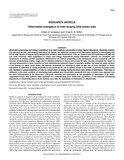| dc.contributor.author | Jonasson, Kristin A. | |
| dc.contributor.author | Willis, Craig K. R. | |
| dc.date.accessioned | 2016-12-09T22:39:58Z | |
| dc.date.available | 2016-12-09T22:39:58Z | |
| dc.date.issued | 2012 | |
| dc.identifier.citation | Jonasson, Kristin A., and Craig K. R. Willis. "Hibernation energetics of free-ranging little brown bats." The Journal of Experimental Biology 215 (2012): 2141-2149. DOI:10.1242/jeb.066514. | en_US |
| dc.identifier.issn | 0022-0949 | |
| dc.identifier.uri | http://hdl.handle.net/10680/1260 | |
| dc.description.abstract | Hibernation physiology and energy expenditure have been relatively well studied in large captive hibernators, especially rodents, but data from smaller, free-ranging hibernators are sparse. We examined variation in the hibernation patterns of free-ranging little brown bats (Myotis lucifugus) using temperature-sensitive radio-transmitters. First, we aimed to test the hypothesis that age, sex and body condition affect expression of torpor and energy expenditure during hibernation. Second, we examined skin temperature to assess whether qualitative differences in the thermal properties of the hibernacula of bats, compared with the burrows of hibernating rodents, might lead to different patterns of torpor and arousal for bats. We also evaluated the impact of carrying transmitters on body condition to help determine the potential impact of telemetry studies. We observed large variation in the duration of torpor bouts within and between individuals but detected no effect of age, sex or body condition on torpor expression or estimates of energy expenditure. We observed the use of shallow torpor in the midst of periodic arousals, which may represent a unique adaptation of bats for conservation of energy during the most costly phase of hibernation. There was no difference in the body condition of hibernating bats outfitted with transmitters compared with that of control bats captured from the same hibernaculum at the same time. This study provides new information on the energetics of hibernation in an underrepresented taxon and baseline data important for understanding how white-nose syndrome, a new disease devastating populations of hibernating bats in North America, may alter the expression of hibernation in affected bats. | en_US |
| dc.description.sponsorship | "This work was supported by grants from the Natural Sciences and Engineering Research Council (NSERC, Canada), the Canada Foundation for Innovation (CFI) and the Manitoba Research and Innovation Fund to C.K.R.W. and a NSERC Canada Graduate Scholarship, a Manitoba Graduate Scholarship and a Bat Conservation International Student Research Scholarship to K.A.J." | en_US |
| dc.description.uri | http://jeb.biologists.org/content/215/12/2141 | |
| dc.language | en | |
| dc.publisher | Company of Biologists | en_US |
| dc.rights | info:eu-repo/semantics/openAccess | |
| dc.subject | Little Brown Bat | en_US |
| dc.subject | Bats -- Metabolism | en_US |
| dc.subject | Hibernation (Biology) | en_US |
| dc.title | Hibernation energetics of free-ranging little brown bats | en_US |
| dc.type | Article | en_US |
| dc.identifier.doi | 10.1242/jeb.066514 | |

